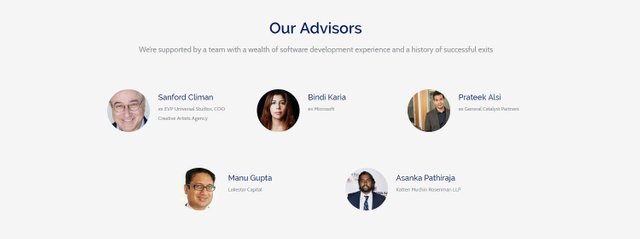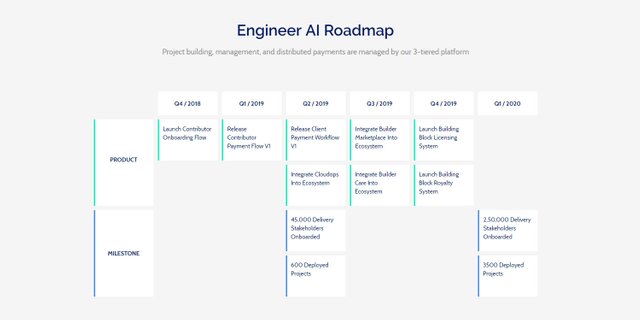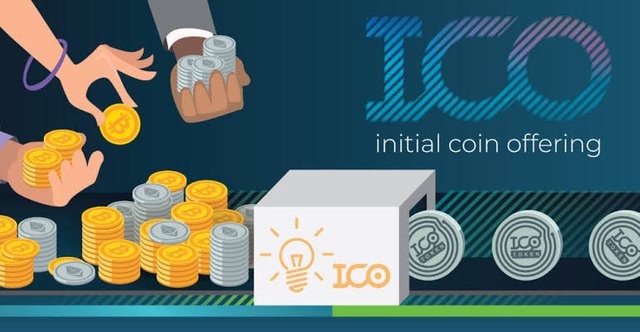ENGINEER.AI PROJECT ((ICO 2018))-AI-POWERED ECOSYSTEM LETS ANYONE CREATE SOFTWARE

Software is a generic term that refers to a collection of data or computer instructions that tell the computer how to work, in contrast to the physical hardware from which the system is built, that actually performs the work. In computer science and software engineering, computer software is all information processed by computer systems, programs and data. Computer software includes computer programs, libraries and related non-executable data, such as online documentation or digital media. Computer hardware and software require each other and neither can be realistically used on its own.
At the lowest level,[clarification needed] executable code consists of machine language instructions specific to an individual processor—typically a central processing unit (CPU) or a graphics processing unit (GPU). A machine language consists of groups of binary values signifying processor instructions that change the state of the computer from its preceding state. For example, an instruction may change the value stored in a particular storage location in the computer—an effect that is not directly observable to the user. An instruction may also invoke one of many input or output operations, for example displaying something text on a computer system; state changes which should be visible to the user. The processor carries out the instructions in the order they are provided, unless it is instructed to "jump" to a different instruction, or is interrupted by the operating system. As of 2015, most personal computers, smartphone devices and servers have processors with multiple execution units or multiple processors performing computation together, and computing has become a much more concurrent activity than in the past.
.svg.png)
An outline (algorithm) for what would have been the first piece of software was written by Ada Lovelace in the 19th century, for the planned Analytical Engine. However, neither the Analytical Engine nor any software for it were ever created.
The first theory about software—prior to creation of computers as we know them today—was proposed by Alan Turing in his 1935 essay On Computable Numbers, with an Application to the Entscheidungsproblem (decision problem).
This eventually led to the creation of the academic fields of computer science and software engineering. Both fields study software and its creation. Computer science is the theoretical study of computer and software (Turing's essay is an example of computer science), where as software engineering is the application of engineering and development of software.
However, prior to 1946, software was not yet the programs stored in the memory of stored-program digital computers, as we now understand it. The first electronic computing devices were instead rewired in order to reprogram them
The majority of software is written in high-level programming languages that are easier and more efficient for programmers to use because they are closer than machine languages to natural languages.[1] High-level languages are translated into machine language using a compiler or an interpreter or a combination of the two. Software may also be written in a low-level assembly language, which has strong correspondence to the computer's machine language instructions and is translated into machine language using an assembler.
In reference with the motive of this article, Today! I will be presenting you a particular undisputed project called: ENGINEER.AI
WHAT IS ENGINEER.AI?

.jpg)

Engineer.aI is a blockchain and AI-powered ecosystem that helps anyone create bespoke software, faster, more cost-effective, and with a higher success rate than the current consultation model.
Project building, management, and distributed payments are all managed by our ecosystem
Engineer.ai development team is established and experienced with an existing network of 26,000 engineers, 3,200 clients, $23 million in platform revenue, and 150 percent year on year growth. Pivoting to a blockchain and AI-driven model will industrialize our process and allow us scale globally and achieve our key goals.
An outline (algorithm) for what would have been the first piece of software was written by Ada Lovelace in the 19th century, for the planned Analytical Engine. However, neither the Analytical Engine nor any software for it were ever created.
The first theory about software—prior to creation of computers as we know them today—was proposed by Alan Turing in his 1935 essay On Computable Numbers, with an Application to the Entscheidungsproblem (decision problem).
This eventually led to the creation of the academic fields of computer science and software engineering. Both fields study software and its creation. Computer science is the theoretical study of computer and software (Turing's essay is an example of computer science), where as software engineering is the application of engineering and development of software.
However, prior to 1946, software was not yet the programs stored in the memory of stored-program digital computers, as we now understand it. The first electronic computing devices were instead rewired in order to "reprogram" them
ABOUT ENGINEER.AI



Engineer.ai launch forms a decentralized platform using an artificial mind, where almost anyone can simply and unconsciously develop software for their entrepreneurial activities in a couple of steps without the skill of programming and knowledge of codes.
The introduction of such software, which is personally developed by the manager of the business manager, takes into account all aspects and subtleties of their organization, processes large amounts of information and uses them effectively, lowers the price policy of human labor discipline, causes defective product stocks, modifies with improved conditions for employees.
Ecosystem engineering and technical artificial intelligence works in an extremely elementary algorithm: the customer inevitably needs to pay for the first deposit of NAYA tokens first, the transaction is carried out with the support of contractual agreements for extraction of necessary minerals, which will help to find the desired final end or compensation, then runs to the workload and selects the necessary ones blocks for your software supply, and the final final end is checked by uncontrolled and uncontrollable professionals.
All operations will be carried out using their personal internal token NAYA, and for each software plan an individual mental contract will be born. The digital token helps to reduce commission fees, unlike traditionally accepted master masters, the price for almost one-second subtracts intermediary conductors in the form of banking and electronic payment constructional orders, preserves all data in absolute confidentiality.
As for the prospects of this idea, this team already has a network of 26,000 engineering masters, 3,200 buyers and 23 million revenue. bucks, it allows us to conclude about a large experimental experiment and a worthy solid foundation of the project. The introduction of technical means of blockchain and artificially made intelligence will allow to increase the total number of customers and to conduct global scaling.
Clients use the drag-and-drop interface to create ideas. They pay NAYA tokens every week to start work.
AI builds a project by selecting a component from an existing building block.
A builder card with details of atomic level is assigned to delivery personnel confirmed with score.
Several independent stake partners will validate the deliverables.
Successful projects automatically release funds escrowed by the smart contract of the block chain.
Hosting and maintenance are managed by AI & Cloud. Costs are automatically arbitrarily chosen.
Our mission: Engineer.ai’s development team has been established and experienced with 26,000 engineers, 3,200 clients, platform revenues of $ 23 million and existing networks with an annual growth rate of 150%. Pivoting to block chains and AI driven models will make the process industrialize, expand globally and achieve key goals.
EXPLANATION VIDEO
ENGINEER.AI TEAM & ADVOISORS BOARD

.jpg)
ENGINEER.AI ROADMAP
(1).png)
.jpg)
ENGINEER.AI ICO ANALYSIS
(3).jpg)
The ICO is a natural supplementary funding source to further accelerate the development and global adoption of the ENGINEER.AI PLATFORM
ENGINEER.AI TOKEN ANALYSIS
.png)
NAYA is an ERC – 20 token used in distributed payment networks for clients and contributors.
.jpg)
CONCLUSION:
Thanks to Blockchain Technology and ENGINEER.AI Platform for introducing better and incomparable ideas in the World Crypto.
For more information about this project, please! follow the link bellow » » »
★WEBSITE: https://token.engineer.ai
★ANN TREAD: https://bitcointalk.org/index.php?topic=5006742
★FACEBOOK: http://www.facebook.com/engineeringai
★REDDIT: https://www.reddit.com/r/EAIToken
★TELEGRAM : https://t.me/eaitoken
★WHITEPAPER: https://s3.ap-south-1.amazonaws.com/engineer.ai-demo/Whitepaper+-+Engineer.ai+v4.01.pdf
★TWITTER: https://twitter.com/engineeringai
••BITCOINTALK USERNAME: Dprince2281
••BITCOINTALK PROFILE LINK: https://bitcointalk.org/index.php?action=profile;u=1907552;sa=summary
Enjoyed the article? Please let me know by giving your vote and send a recommendation to a friend. Thank you!
AUTHOR: Dprince2281